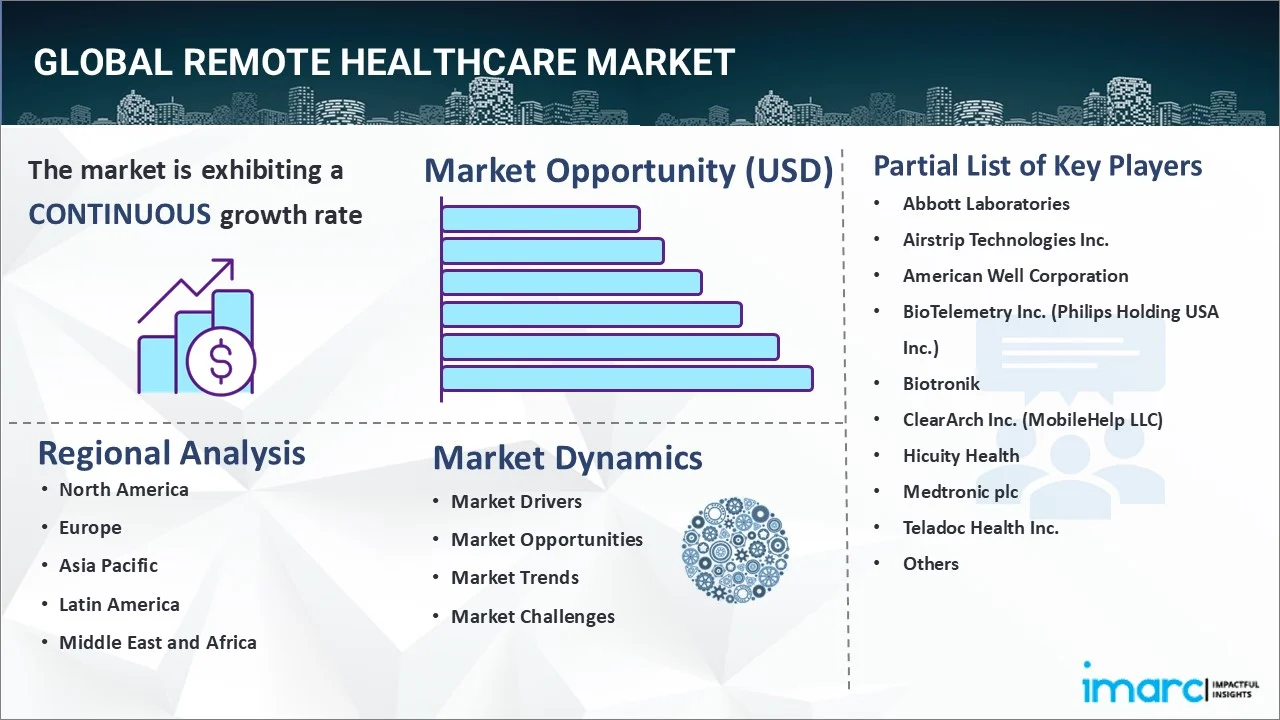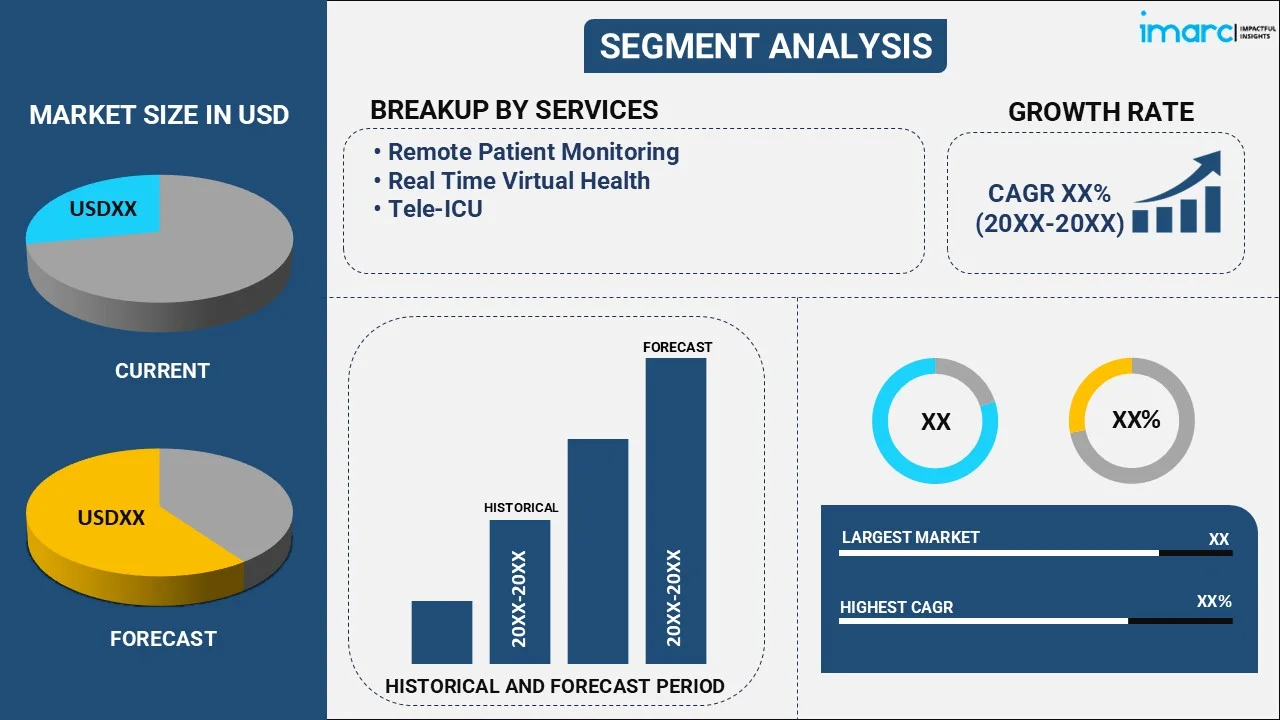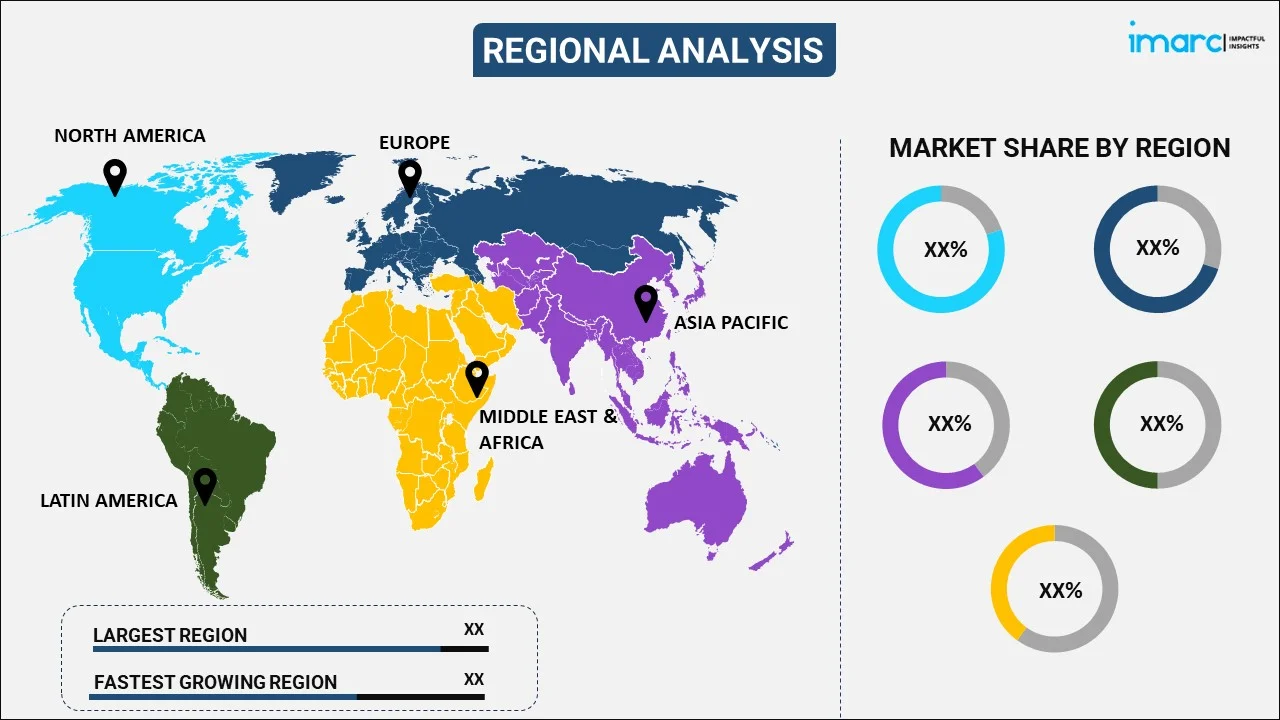
Remote Healthcare Market by Service (Remote Patient Monitoring, Real Time Virtual Health, Tele-ICU), Application (Diagnosis, Cardiology, Obstetrics, Senior Care, and Others), End User (Payer, Provider, Patient, Employer Groups and Government Organizations), and Region 2025-2033
Market Overview:
The global remote healthcare market size reached USD 12.7 Billion in 2024. Looking forward, IMARC Group expects the market to reach USD 48.3 Billion by 2033, exhibiting a growth rate (CAGR) of 15.87% during 2025-2033. The increasing prevalence of chronic diseases, the integration of telecommunications and artificial intelligence (AI) platforms, and the implementation of favorable government initiatives to promote telehealth applications are some of the major factors propelling the market.
|
Report Attribute
|
Key Statistics
|
|---|---|
|
Base Year
|
2024 |
|
Forecast Years
|
2025-2033 |
|
Historical Years
|
2019-2024
|
| Market Size in 2024 | USD 12.7 Billion |
| Market Forecast in 2033 | USD 48.3 Billion |
| Market Growth Rate 2025-2033 | 15.87% |
Remote healthcare refers to the delivery of health services and information through electronic and telecommunication technologies. This enables healthcare providers to diagnose, consult, treat, and monitor patients without the need for physical presence, thereby extending medical assistance to locations that are geographically distant or otherwise hard to reach. It also encompasses a range of services, including telemedicine consultations via video calls, remote patient monitoring through wearable devices, and digital platforms that offer medical advice or prescriptions. It's a comprehensive approach to healthcare that leverages technology to bridge the gap between patients and medical professionals, making healthcare more accessible, cost-effective, and efficient.

The growth of the remote healthcare market is propelled by several key drivers, contributing to its expanding reach and effectiveness. Technological advancements in telecommunication and data analytics facilitate real-time monitoring and consultations, making remote healthcare more accessible and efficient, representing another major growth-inducing factor. In addition, the rising healthcare costs have intensified the search for cost-effective alternatives, positioning remote healthcare as a viable solution. Besides, government initiatives and favorable policies are accelerating the adoption of remote healthcare services. Additionally, demographic shifts, such as an aging population, drive the need for convenient healthcare solutions. Moreover, the COVID-19 pandemic further underscored the importance of remote healthcare in emergency situations, leading to increased investment in this sector.
Remote Healthcare Market Trends/Drivers:
Increasing prevalence of chronic diseases
Chronic conditions like diabetes, hypertension, and heart disease require continuous monitoring and long-term care, making remote healthcare services particularly useful for managing these ailments. Remote patient monitoring systems can collect data on vital signs, glucose levels, and other relevant metrics, allowing healthcare providers to make timely interventions. This continuous data stream aids in effective disease management and potentially prevents complications, thereby reducing hospitalizations and associated healthcare costs. Furthermore, telemedicine consultations offer the convenience of routine check-ups from the comfort of one's home, which is particularly beneficial for patients with mobility challenges or those living in remote areas. In essence, the rise in chronic diseases amplifies the need for flexible, efficient, and continuous healthcare, attributes inherently provided by remote healthcare services. As a result, the demand for remote healthcare options is likely to grow commensurately with the rising incidence of chronic health conditions.
Integration of advanced technologies such as AI
AI algorithms can analyze large sets of medical data to assist in diagnosing conditions more quickly and accurately. This can be especially useful in remote settings where immediate access to specialists may not be available. Moreover, Telecommunications technology facilitates real-time data transmission from wearable devices and other monitoring tools. When coupled with AI, it can send alerts for any abnormalities, enabling timely medical intervention. Besides, high-quality video conferencing tools have made virtual consultations almost as effective as in-person visits, expanding healthcare access to remote or underserved areas. Moreover, advances in cybersecurity technologies ensure that patient data remains confidential and secure, a critical factor for widespread adoption of remote healthcare services.
Implementation of favorable government initiatives
These policies have provided the legal and regulatory framework needed for telehealth services to operate effectively, thereby reducing entry barriers and encouraging more healthcare providers to adopt remote healthcare technologies. Financial incentives, grants, or subsidies from government bodies also make it financially viable for healthcare organizations to invest in the necessary infrastructure, such as telecommunication equipment and software platforms. Additionally, in many countries, government-led public awareness campaigns have played a key role in educating both healthcare providers and the general populace about the benefits of remote healthcare, such as increased accessibility and cost-effectiveness. Moreover, by including telehealth services in public and private healthcare reimbursement schemes, governments have further elevated their legitimacy and acceptability, thus encouraging more patients and healthcare providers to participate.
Remote Healthcare Industry Segmentation:
IMARC Group provides an analysis of the key trends in each segment of the global remote healthcare market report, along with forecasts at the global, regional and country levels from 2025-2033. Our report has categorized the market based on service, application and end user.
Breakup by Service:

- Remote Patient Monitoring
- Real Time Virtual Health
- Video Communication
- Audio Communication
- Email/Chat box
- Tele-ICU
Tele-ICU currently dominates the market
The report has provided a detailed breakup and analysis of the market based on the service. This includes remote patient monitoring, real time virtual health (video communication, audio communication, email/chat box), and tele-ICU. According to the report, tele-ICU represented the largest segment.
ICU units are high-stakes environments that require specialized care. Given the shortage of intensivists and critical care nurses in many regions, Tele-ICU can provide the needed expertise remotely, ensuring timely and high-quality care. Moreover, Tele-ICU allows a centralized team of experts to monitor and consult on multiple cases from different locations simultaneously. This model scales well, offering smaller hospitals access to specialized care that they may not be able to afford otherwise. Moreover, advancements in sensors, real-time data analytics, and high-definition video conferencing have made it possible to deliver highly sophisticated ICU services remotely, narrowing the gap between remote and in-person care.
Breakup by Application:
- Diagnosis
- Cardiology
- Obstetrics
- Senior Care
- Others
A detailed breakup and analysis of the market based on the application has also been provided in the report. This includes diagnosis, cardiology, obstetrics, senior care, and others.
Diagnosis primarily focuses on the use of telehealth technologies for diagnosing medical conditions. It involves consultations via video calls, image sharing for radiological or dermatological evaluations, and other remote diagnostic tests. As this often serves as the entry point for further medical treatment, its growth is critical for the overall expansion of the remote healthcare market.
Remote healthcare applications in cardiology include continuous monitoring of heart rate, blood pressure, and ECG through wearable devices. These data can be transmitted to healthcare providers for real-time analysis, allowing for timely interventions, medication adjustments, and emergency care if needed. This segment is particularly crucial for managing chronic conditions like hypertension and heart failure.
Telehealth in obstetrics enables prenatal and postnatal care to be provided remotely. It can involve virtual consultations, sharing of ultrasound images, and remote monitoring of vital statistics for both the mother and the unborn child. This is particularly beneficial in areas where specialized obstetric care is not easily accessible.
Moreover, with an aging population that may find it challenging to visit healthcare facilities regularly, remote healthcare is becoming increasingly essential. Technologies such as fall detection, medication reminders, and tele-consultations are helping seniors receive healthcare services without leaving their homes. This segment is expected to grow significantly, given the demographic trends.
Breakup by End User:
- Payer
- Provider
- Patient
- Employer Groups and Government Organizations
Provider hold the largest share in the market
A detailed breakup and analysis of the market based on the end user has also been provided in the report. This includes payer, provider, patient, and employer groups and government organizations. According to the report, provider accounted for the largest market share.
Healthcare providers include hospitals, clinics, and individual medical practitioners who use telehealth technologies to consult, diagnose, treat, and monitor patients. As the main point of contact for patients seeking medical services, providers naturally have a significant stake in the expansion and adoption of remote healthcare solutions. Firstly, the technology infrastructure needed to facilitate remote healthcare, such as telecommunication equipment, software platforms, and wearable devices, is generally set up and maintained by healthcare providers. They invest in these technologies to extend their reach and provide services to a broader and more geographically dispersed patient base. In addition, providers benefit from the cost-efficiency that remote healthcare offers. Moreover, healthcare providers are directly involved in implementing and adapting to changes in regulations and reimbursement models related to remote healthcare.
Breakup by Region:

- North America
- United States
- Canada
- Asia-Pacific
- China
- Japan
- India
- South Korea
- Australia
- Indonesia
- Others
- Europe
- Germany
- France
- United Kingdom
- Italy
- Spain
- Russia
- Others
- Latin America
- Brazil
- Mexico
- Others
- Middle East and Africa
North America exhibits a clear dominance in the market
The market research report has also provided a comprehensive analysis of all the major regional markets, which include North America (the United States and Canada); Europe (Germany, France, the United Kingdom, Italy, Spain, Russia, and others); Asia Pacific (China, Japan, India, South Korea, Australia, Indonesia, and others); Latin America (Brazil, Mexico, and others); and the Middle East and Africa. According to the report, North America accounted for the largest market share.
North America, particularly the United States and Canada, has advanced telecommunication networks and widespread internet access, crucial for the effective deployment of remote healthcare. Moreover, federal and state-level policies in North America are increasingly favorable towards telehealth. Incentives, grants, and other forms of financial support from the government make it more appealing for healthcare providers to invest in remote healthcare technologies. Insurance companies in the region are also more likely to cover telehealth services, further accelerating its adoption. Besides, healthcare spending in North America is among the highest globally, and there's a continuous search for cost-effective alternatives to traditional healthcare delivery methods. Remote healthcare offers a solution to this, providing cost-effective and efficient ways to deliver medical services.
Competitive Landscape:
The competitive landscape of the market is both dynamic and diversified, characterized by the presence of multiple players that include established brands and emerging startups. Presently, leading companies are investing heavily in R&D to develop new technologies and improve existing solutions. This includes enhancing the capabilities of telehealth platforms, creating more accurate wearable devices for remote patient monitoring, and integrating advanced features like Artificial Intelligence and machine learning to make the systems more efficient. They are also forming alliances with healthcare providers, insurance firms, and even technology companies to offer comprehensive solutions that go beyond their individual capabilities. Besides, key players are focusing on ensuring that their solutions are compliant with the laws of the regions in which they operate. This strengthens their reputation and fosters trust among consumers and healthcare providers.
The market research report has provided a comprehensive analysis of the competitive landscape in the market. Detailed profiles of all major companies have also been provided. Some of the key players in the market include:
- Abbott Laboratories
- Airstrip Technologies Inc.
- American Well Corporation
- BioTelemetry Inc. (Philips Holding USA Inc.)
- Biotronik
- ClearArch Inc. (MobileHelp LLC)
- Hicuity Health
- Medtronic plc
- Teladoc Health Inc.
- University of Pittsburgh Medical Center
- Vivify Health Inc.
Recent Developments:
- In August 2022, Teladoc Health and Cloud DX announced a partnership to enhance remote monitoring solutions for patients.
- In August 2022, Hicuity Health introduced tele-ICU services at MUSC Health Columbia Medical Center Downtown, located in Columbia, South Carolina. This recent service expansion builds upon the established partnership between MUSC Health and Hicuity Health, known for providing telemedicine services to various hospitals throughout the state.
- In 2021, Philips Holdings, a prominent player in health technology, has successfully finalized the acquisition of BioTelemetry, Inc, a reputable provider specializing in remote cardiac diagnostics and monitoring.
Remote Healthcare Market Report Scope:
| Report Features | Details |
|---|---|
| Base Year of the Analysis | 2024 |
| Historical Period | 2019-2024 |
| Forecast Period | 2025-2033 |
| Units | Billion USD |
| Scope of the Report | Exploration of Historical Trends and Market Outlook, Industry Catalysts and Challenges, Segment-Wise Historical and Predictive Market Assessment:
|
| Services Covered |
|
| Applications Covered | Diagnosis, Cardiology, Obstetrics, Senior Care, Others |
| End Users Covered | Payer, Provider, Patient, Employer Groups and Government Organizations |
| Regions Covered | Asia Pacific, Europe, North America, Latin America, Middle East and Africa |
| Countries Covered | United States, Canada, Germany, France, United Kingdom, Italy, Spain, Russia, China, Japan, India, South Korea, Australia, Indonesia, Brazil, Mexico |
| Companies Covered | Abbott Laboratories, Airstrip Technologies Inc., American Well Corporation, BioTelemetry Inc. (Philips Holding USA Inc.), Biotronik, ClearArch Inc. (MobileHelp LLC), Hicuity Health, Medtronic plc, Teladoc Health Inc., University of Pittsburgh Medical Center, Vivify Health Inc., etc. |
| Customization Scope | 10% Free Customization |
| Post-Sale Analyst Support | 10-12 Weeks |
| Delivery Format | PDF and Excel through Email (We can also provide the editable version of the report in PPT/Word format on special request) |
Key Benefits for Stakeholders:
- IMARC’s industry report offers a comprehensive quantitative analysis of various market segments, historical and current market trends, market forecasts, and dynamics of the remote healthcare market from 2019-2033.
- The research report provides the latest information on the market drivers, challenges, and opportunities in the global remote healthcare market.
- The study maps the leading, as well as the fastest-growing, regional markets. It further enables stakeholders to identify the key country-level markets within each region.
- Porter's five forces analysis assist stakeholders in assessing the impact of new entrants, competitive rivalry, supplier power, buyer power, and the threat of substitution. It helps stakeholders to analyze the level of competition within the remote healthcare industry and its attractiveness.
- Competitive landscape allows stakeholders to understand their competitive environment and provides an insight into the current positions of key players in the market.
Key Questions Answered in This Report
The global remote healthcare market was valued at USD 12.7 Billion in 2024.
We expect the global remote healthcare market to exhibit a CAGR of 15.87% during 2025-2033.
The rising prevalence of numerous chronic and cardiovascular diseases, along with the growing need for real-time virtual health services to monitor patients regularly, is primarily driving the global remote healthcare market.
The sudden outbreak of the COVID-19 pandemic and the loss of beds across various healthcare institutions have led to the widespread adoption of remote healthcare technologies to combat the spread of the coronavirus infection upon hospital visits.
Based on the service, the global remote healthcare market has been segregated into remote patient monitoring, real time virtual health, and tele-ICU. Among these, tele-ICU currently holds the largest market share.
Based on the end user, the global remote healthcare market can be bifurcated into payer, provider, patient, and employer groups and government organizations. Currently, provider exhibits a clear dominance in the market.
On a regional level, the market has been classified into North America, Asia-Pacific, Europe, Latin America, and Middle East and Africa, where North America currently dominates the global market.
Some of the major players in the global remote healthcare market include Abbott Laboratories, Airstrip Technologies Inc., American Well Corporation, BioTelemetry Inc. (Philips Holding USA Inc.), Biotronik, ClearArch Inc. (MobileHelp LLC), Hicuity Health, Medtronic plc, Teladoc Health Inc., University of Pittsburgh Medical Center, and Vivify Health Inc.
Need more help?
- Speak to our experienced analysts for insights on the current market scenarios.
- Include additional segments and countries to customize the report as per your requirement.
- Gain an unparalleled competitive advantage in your domain by understanding how to utilize the report and positively impacting your operations and revenue.
- For further assistance, please connect with our analysts.
 Inquire Before Buying
Inquire Before Buying
 Speak to an Analyst
Speak to an Analyst
 Request Brochure
Request Brochure
 Request Customization
Request Customization




.webp)




.webp)












